Question 1:
Plants are called as ________________ because it fixes carbondioxide.
Answer:
autotrophs
Question 2:
In ecosystem, dominated by trees, the pyramid is ________________ type.
Answer:
upright
Question 3:
In aquatic ecosystems, the limiting factor for the productivity is ________________ .
Answer:
light
Question 4:
Common detritivores in our ecosystem are ________________ .
Answer:
earthworms and soil microbes. (Bacteria and fungi)
Question 5:
The major reservoir of carbon is ________________ .
Answer:
ocean
Question 6:
Which one of the following has the largest population in a food chain ?
Answer:
Decomposers
Question 7:
Second most important trophic level in a lake is
Answer:
Zooplankton
Question 8:
Secondary producers are
Answer:
Herbivores
Question 9:
What is the percentage of photosynthetically active radiation (PAR), if incident solar radiation is considered 100% ?
Answer:
50%
Question 10:
Distinguish between the grazing food chain and detritus food chain.
Answer:
Differences between grazing food chain and detritus food chain.
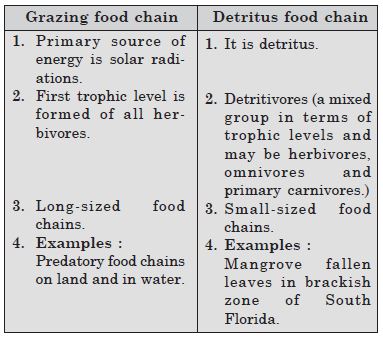
Question 11:
Distinguish between the production and decomposition.
Answer:
Differences between production and decomposition.

Question 12:
Distinguish between the upright and inverted pyramid.
Answer:
Differences between Upright pyramid and Inverted pyramid.

Question 13:
Distinguish between the food chain and food web.
Answer:
Differences between food chain and food web.
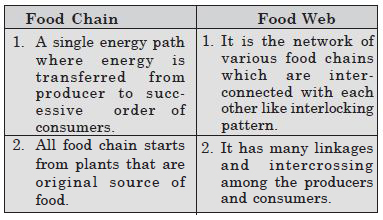
Question 14:
Distinguish between the litter and detritus.
Answer:
Differences between litter and detritus.

Question 15:
Distinguish between the primary and secondary productivity.
Answer:
Differences between primary productivity and secondary productivity
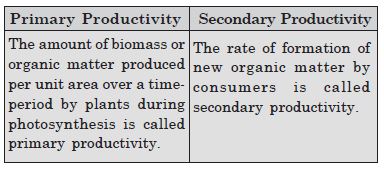
Question 15:
Describe the components of an ecosystem.
Answer:
Ecosystem. A stable, self-supporting ecological unit resulting from an interaction between
biotic community (living organisms) and its abiotic environment is called ecosystem.
An ecosystem comprises two main
components : (i) biotic including plants, animals and microorganisms : and (ii) abiotic
mainly including substratum, water, minerals, carbon dioxide and oxygen. It must also
receive a constant supply of energy (light).
Biotic components Of an ecosystem’s biotic components, the plants are producers as they
introduce food materials and energy into the living world. The animals are consumers because
they get food and energy by consuming plants directly thus called primary consumers
(herbivores) secondary / tertiary consumers (carnivores) obtain energy and food indirectly
from plants; and microorganisms are decomposers for they flourish by breaking dead organic
matter to simple substances that are returned to environment for reuse by plants. In an
ecosystem, nutrients are used again and again in a cyclic manner, whereas energy trapped
from sunlight is lost as heat.
Abiotic components
(i) Climate including temperature, light, wind, gases, humidity, rain and water (also wave
action, water currents) ; and (ii) edaphic including soil, substratum, topography,
background, minerals and pH.
Question 16:
Define ecological pyramid and describe pyramids of number and biomass.
Answer:
Definition. An ecological pyramid is a graphical representation of an ecological parameter,
like number or biomass or accumulated energy at different trophic levels in a food chain in
an ecosystem.
(1) Pyramid of number. Pyramid is the mathematical representation of number of organisms
present at each trophic level in a food chain of a particular ecosystem. When the number of
organisms at successive levels are calculated mathematically and plotted, they assume the
shape of a pyramid. This is called a pyramid of number. The base represents the number of
producers where as tip is represented by top consumers, inverted pyramids can also be
formed.
In the given pyramid of number, number of producers (here grass and trees are the producers)
will be far more than any other level. The number of consumers will be comparatively less
than herbivores. You can guess if number of carnivores increase and exceeds the herbivores
then what will be the result ?
Fig. shows inverted pyramid and there you can see producer is one tree and dependents like
primary and secondary consumers are many parasite insects of birds will be definitely more
than the number of birds.
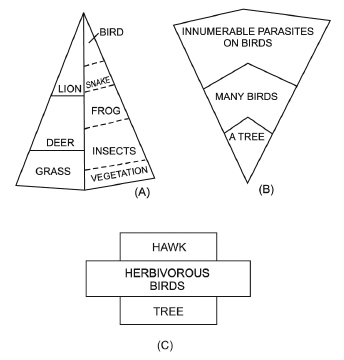
Straight—Forest and Water ecosystem B. Inverted—Tree Ecosystem. C. Spindle shaped
(2) Pyramid of Biomass. Biomass is defined as the total weight of dry matter present in an
ecosystem in one time. Graphical measurement of biomass is called pyramid of biomass. Trophic
levels at base represent biomass as numbers in a pyramid of number. Here also you can obtain
upright and inverted pyramid.
Aquatic pyramid of biomass is always inverted because the biomass of fishes far exceeds the
biomass of phytoplankton.

Inverted–Aquatic ecosystem.
Question 17:
What is primary productivity? Give brief description of factors that affect primary productivity.
Answer:
(The amount of biomass or organic matter produced per unit area over a time period by plants
during photosynthesis is called primary productivity.
It is expressed in terms of gm–2yr–1 or
kcalm–2yr–1. Primary productivity depends upon a number of
environmental factors like :
(a) Availability of nutrients which varies in different types of ecosystem.
(b) Photosynthetic capacity of plants.
(c) The plant species inhabiting in a particular area.
(d) Environmental factors.
Question 18:
Describe the process of decomposition of detritus under following heads : Fragmentation, leaching, catabolism, homification and mineralization.
Answer:
Refer to Baiscs and Basis.
Question 19:
Give an account of energy flow in an ecosystem.
Answer:
Different components for a universal model of energy flow are:
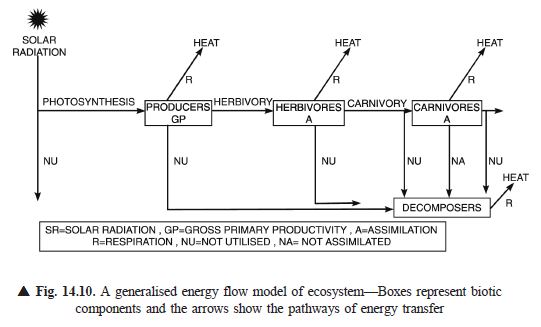
When a herbivore eats a plant, then it digests and oxidizes the ingested food
to liberate energy which is equal to that used in synthesizing the organic biomass by the
plant. Some of the released energy is lost as heat while only a part of energy is used in
building the biomass of the herbivore, called gross secondary productivity. The same is
repeated when the herbivore is eaten by a primary carnivore and so on. At each transfer,
about 80-90% of potential energy is dissipated as heat while only 10-20% of energy is
available to next trophic level. Thus, there is a decline in the amount of energy passing
from one trophic level to the next trophic level. The study of energy transfer was called
bioenergetics.
Secondary productivity tends to be about 10 per cent at the herbivore level, although
efficiency may be higher, as 20 per cent at the carnivore level.
So regarding the energy flow, an ecosystem is characterized by :
1. Unidirectional flow of energy.
2. Decrease in useful energy.
3. Return of radiant energy of sun to non-living system as heat.
Question 20:
Outline salient features of carbon cycling in an ecosystem.
Answer:
The reservoirs of carbon are :
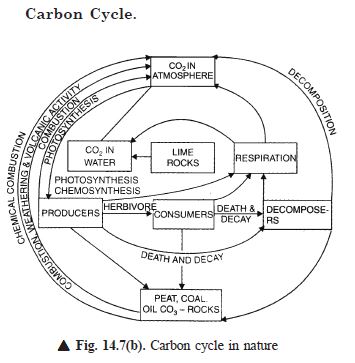
Basics and Basis.
(1) Carbon dioxide present in air.
(2) Carbon dissolved in water.
(3) Carbonates in earth’s crust.
(4) Fossil fuels like coal and petroleum.
(5) Bicarbonates in oceans.
Carbon cycle is the simplest of all nutrient cycles.
Its salient features are :
(1) CO2 utilization : Carbon dioxide is used by green plants for the process of
photosynthesis and oxygen is released as a by-product. The fixed carbon enters the food chain
and passed to harbivores, carnivores, decomposers. About 4 × 1013 kg of carbon is
fixed in biosphere through photosynthesis annually.
(2) CO2 production and return to atmosphere.
(a) Carbon dioxide is released into the atmosphere by respiration of producers and
consumers.
(b) It is also released by decomposition of organic wastes and dead bodies by decomposers by the
action of bacteria and fungi of decay.
(c) Burning of wood and fossil fuels also produces CO2.
(d) Volcanic eruptions and hot springs also release CO2 into the atmosphere.
(e) Weathering of carbonate containing rocks by the action of acids also add CO2 to
the atmosphere.
Question 21:
Among the ecosystem services are control of floods and soil erosion. How is this achieved by the biotic components of the ecosystem ?
Answer:
1. Earth’s rich biodiversity is vital for indirect benefits like control of floods and soil
erosion. Species richness checks soil erosion by binding the soil particles thereby reducing
the rate of water velocity, hence reducing the chances of floods.
2. Roots of plants make the soil porous.
